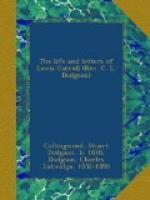A child was asked to define charity. He said it was “givin’ away what yer didn’t want yerself.” This was some people’s idea of self-sacrifice; but it was not Christ’s. Then as to serving others in view of reward: Mr. Lewis Carroll put this view of the subject very forcibly in his “Sylvie and Bruno”—an excellent book for youth; indeed, for men and women too. He first criticised Archdeacon Paley’s definition of virtue (which was said to be “the doing good to mankind, in obedience to the will of God, and for the sake of everlasting happiness,”) and then turned to such hymns as the following:—
Whatever, Lord, we lend to Thee,
Repaid a thousandfold shall be,
Then gladly will we give to Thee,
Giver of all!
Mr. Carroll’s comment was brief and to the point. He said: “Talk of Original Sin! Can you have a stronger proof of the Original Goodness there must be in this nation than the fact that Religion has been preached to us, as a commercial speculation, for a century, and that we still believe in a God?” ["Sylvie and Bruno,” Part i., pp. 276, 277.] Of course it was quite true, as Mr. Carroll pointed out, that our good deeds would be rewarded; but we ought to do them because they were good, and not because the reward was great.
In the Preface to “Sylvie and Bruno,” Lewis Carroll alluded to certain editions of Shakespeare which seemed to him unsuitable for children; it never seemed to strike him that his words might be read by children, and that thus his object very probably would be defeated, until this fact was pointed out to him in a letter from an unknown correspondent, Mr. J.C. Cropper, of Hampstead. Mr. Dodgson replied as follows:—
Dear Sir,—Accept my best thanks for your thoughtful and valuable suggestion about the Preface to “Sylvie and Bruno.” The danger you point out had not occurred to me (I suppose I had not thought of children reading the Preface): but it is a very real one, and I am very glad to have had my attention called to it.
Believe me, truly yours,
Lewis Carroll.
Mathematical controversy carried on by correspondence was a favourite recreation of Mr. Dodgson’s, and on February 20, 1890, he wrote:—
I’ve just concluded a correspondence with a Cambridge man, who is writing a Geometry on the “Direction” theory (Wilson’s plan), and thinks he has avoided Wilson’s (what I think) fallacies. He hasn’t, but I can’t convince him! My view of life is, that it’s next to impossible to convince anybody of anything.
The following letter is very characteristic. “Whatsoever thy hand findeth to do, do it with all thy might,” was Mr. Dodgson’s rule of life, and, as the end drew near, he only worked the harder:—
Christ Church, Oxford, April 10, 1890.




